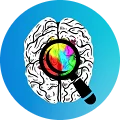Specific learning disorder, which is characterized by performance that is substantially below what would be expected given the person’s age, intelligence quotient (IQ) score, and education. a specific learning disorder, which is defined as a significant discrepancy between a person’s academic achievement and what would be expected for someone of the same age referred to by some as “unexpected underachievement”.
Although school as a ‘socializing agent’ is considered crucial in the overall development of the child, the focus invariably remains on the academic progress of the child. Children display differences in their approaches to learning, with some learning in one go, some requiring personal attention, and yet others, failing to comprehend the concepts and require repeated efforts on part of the educators and parents. Children with learning disability (LD) experience an inability to receive and process information in the brain. Often average or above average in intelligence, these children fail to meet academic standards as their counterparts and are termed as slow learners.
“Specific Learning Disabilities means a disorder in one or more of the basic psychological processes involved in understanding or in using language, spoken or written, which may manifest itself in an imperfect ability to listen, speak, read, spell or to do mathematical calculations”.
Types Learning Disabilities.
1. Dyslexia
- Difficulty in reading
- Inability to distinguish rhyming words from nursery rhymes
- Letters and/or reversing of words while reading (d/b, p/q, saw/was)
- Difficulty with spellings, inability to copy correctly, and often shows phonic versions in spellings like phone- fon.
2. Dysgraphia
- Difficulty in writing
- Experience unpleasantness in drawing, showing difficulty in colouring within boundaries
- Displays handwriting difficulty in terms of spacing, alignment of alphabets, mirror images of words and letters
- Difficulty in written expressions like absence of punctuation marks, inability to follow grammatical rules (comes becomes comed), limited vocabulary.
3. Dyscalculia
- Difficulty with mathematics
- Displaying inability in pre math concepts like comparison (big-small, high-low), counting, sorting etc.
- Confusion with rules and steps for addition, subtraction, multiplication and division.
- Difficulty in telling time, understanding money and measurement concepts.
4. Dyspraxia
- Inability in planning and completing fine motor skills
- Poor sense of direction
- Difficulty in walking, hopping, throwing and catching ball, etc.
- Higher sensitivity to touch (experiencing unpleasantness in nail cutting, hair combing, tooth brushing)
5. Nonverbal learning disability
- Inability to recognize and translate nonverbal cues
- Poor coordination (acts clumsily)
- Poor fine motor skills (unable to tie show lace)
- Unable to recognize facial expressions and body language
Diagnostic Criteria for Specific Learning Disorder.
A. Difficulty learning and using academic skills, as indicated by the presence of at least one of the following symptoms that have persisted for at least 6 months, despite the provision of interventions that target those difficulties:
1. Inaccurate or slow and effortful word reading (e.g., reads single words aloud incorrectly or slowly and hesitantly)
2. Difficulty understanding the meaning of what is read (e.g., may read text accurately but not understand the sequence, relationships, inferences, or deeper meanings of what is read).
3. Difficulties with spelling (e.g., may add, omit, or substitute vowels or consonants).
4. Difficulties with written expression (e.g., makes multiple grammatical or punctuation errors within sentences; employs poor paragraph organization, written expression of ideas lacks clarity).
5. Difficulties mastering number sense, number facts, or calculation (e.g., has poor understanding of numbers, counts on fingers to add single-digit numbers instead of recalling the math fact as peers do)
6. Difficulties with mathematical reasoning (e.g., has severe difficulty applying mathematical concepts, facts)
B. The affected academic skills are substantially and quantifiably below those expected for the individual’s chronological age and cause significant interference with academic or occupational performance, or with activities of daily living, as confirmed by individually administered standardized achievement measures and comprehensive clinical assessment.
C. The learning difficulties begin during school-age years but may not become fully manifest until the demands for those affected academic skills exceed the individual’s limited capacities (e.g., as in timed tests, reading or writing lengthy complex reports for a tight deadline)
D. The learning difficulties are not better accounted for by intellectual disabilities, uncorrected visual or auditory acuity, other mental or neurological disorders, psychosocial adversity.
Note: The four diagnostic criteria are to be met based on clinical synthesis of the individual’s history (developmental, medical, family, educational), school reports, and psychoeducational assessment.
Specify if:
- With impairment in reading:
Word reading accuracy
Reading rate or fluency
Reading comprehension - With impairment in expression:
Spelling accuracy
Grammar and punctuation accuracy
Clarity or organization of written expression - With impairment in mathematics:
Number Sense
Memorization of arithmetic facts
Accurate or fluent calculation
Accurate math reasoning
Causes of Learning Disorder.
The causes of specific learning disorder include genetic, neurobiological, and environmental factors. The genetic research in this area is particularly complex. It is clear that learning disorders run in families, and sophisticated family and twin studies bear this out.
1. Genetics. Genetics (a branch of biology concerned with the study of genes and heredity in organisms) can play a role when it comes to learning disabilities. Children/individuals are more likely to have a learning disorder if their first-degree relatives like a parent or a sibling also suffered from the same.
2. Psychological trauma. The risk of learning disability can be increased if one has experienced psychological trauma or abuse early in their childhood which may have a negative impact on the development of their brain.
3. Prenatal and Neonatal risks. Prenatal risks are a number of dangers that can pose a potential risk to the growing fetus (baby-to-be) during a pregnancy. Neonatal risks are those which can affect a newborn.
Reference,
David H. Barlow, V. Mark Durand. Abnormal Psychology, An Integrative Approach. (7th ed).
Subscribe to Careershodh
Get the latest updates and insights.
Join 17,351 other subscribers!
Niwlikar, B. A. (2022, August 23). Learning Disorder.. Careershodh. https://www.careershodh.com/learning-disorder/
